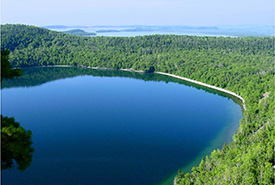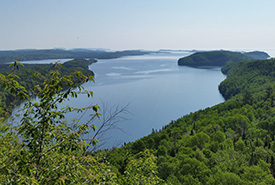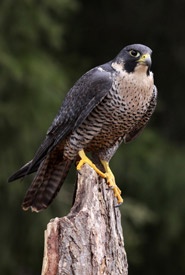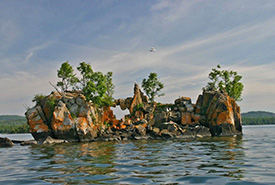Big Trout Bay

Bird's-eye view of Trout Bay, Lake Superior, ON. (Photo by John Anderson)
A conservation success 15 years in the making
The Nature Conservancy of Canada (NCC) is known for thinking big. Our projects span hundreds of kilometres, protect long-ranging wildlife corridors, cross provincial borders and even extend across nations.
Big Trout Bay is one of these projects.
Located on the north shore of Lake Superior, the spectacular 1,010-hectare (2,495-acre) property is one of the last privately owned, undeveloped stretches of shoreline between Duluth, Minnesota, and Thunder Bay, Ontario.
“This was a massive international undertaking,” said James Duncan, the late regional vice-president in Ontario with NCC. “But when faced with the potential loss of habitat and wildlife on the largest freshwater lake in the world, thinking big is essential. It’s an extraordinary opportunity to make substantive and tangible progress on our overall goal of protecting the Superior north shore.”
“Big Trout Bay is certainly big in name and importance,” said Gary Davies, program director for northwestern Ontario. “The area has seen a lot of shoreline development over the past few decades. It is home to incredible vistas and important habitat for a variety of boreal species, such as lynx and moose.”

Looking down over Big Trout Bay, Lake Superior, ON (Photo by NCC)
A refuge for wildlife
Located just minutes from the international border, and 45 minutes from Thunder Bay, Big Trout Bay’s densely forested land is crucial to several native species. This includes bald eagles and peregrine falcons.
Peregrine falcons are one of Canada’s success stories. In the 1970s, these raptors were almost extinct in Canada due to the use of industrial pesticides. But thanks to conservation efforts, their populations have begun to bounce back. Big Trout Bay is just one of the ways NCC is helping to protect habitat for species like the peregrine falcon.
Big Trout Bay is composed mostly of coastal boreal forest. Nearly half of Canada’s bird species rely on boreal habitat to complete their life cycle. Many of these species migrate throughout the Americas.
The property also protects 21 kilometres of undeveloped shoreline with towering cliffs, stretches of open bedrock and rugged cobble beach. These shoreline areas are especially important for biodiversity. They provide varied habitat for species such as bird’s-eye primrose, lake trout and moose.
The power of partnership
A project of this magnitude would have been expensive to complete in the U.S. However, it was made possible on the Canadian side of the border thanks to funding from the Government of Canada through the Natural Areas Conservation Program. Other generous partners included:
- JA Woollam Foundation
- Margaret A. Cargill Foundation
- Bobolink Foundation
- The Nature Conservancy’s (U.S.) Wisconsin and Minnesota programs
- The Conservation Fund
- Green Leaf Advisors
- The Rogers Foundation
- and many individual donors in both the United States and Canada

Peregrine falcon (Photo by Chris Hill)
“The long journey to acquire this special property was certainly worth it,” said Davies. “For over 10 years, NCC worked to acquire Big Trout Bay. With the support of generous and concerned supporters, we made it happen.”
Through partnerships on both sides of the border, NCC will ensure that this stunning example of North American natural heritage remains a home for wildlife, a haven for recreation and provides vital sustenance to the Great Lakes Basin on which the U.S. and Canada both rely so heavily.
“Lake Superior’s Big Trout Bay, McKellar Point and Pine Point represent the last unsecured Great Lakes wilderness on the continent — truly a global gem,” said Tom Duffus, midwest vice president for The Conservation Fund. The fund provided bridge financing as well as transactional and fundraising assistance to NCC via its Great Lakes Revolving Fund. “After more than 15 years of work personally on this project, I understand the importance of preserving the natural view the Voyageurs saw and, equally as important, the ecosystems that have sustained First Nations for generations.”
“The Nature Conservancy is proud to support this bi-national effort to protect the Great Lakes. Protection of the land at Big Trout Bay builds on other Great Lakes conservation successes, including St. Martin Island in Lake Michigan and Clough Island in Lake Superior’s St. Louis River Estuary,” said Mary Jean Huston, who directs The Nature Conservancy’s work in Wisconsin. “Working together, we can keep the Great Lakes beautiful, healthy and productive today and for generations to come.”
Connecting nature lovers to wilderness

Rock formation on the north shore of Lake Superior, ON (Photo by Carol DeSain)
Part of the Nature Destination program, vistors are encouraged to visit Big Trout Bay and hike the 9.8-kilometre James Duncan Nature Trail. To learn more vist NCC's Nature Destinations page.
The late James Duncan joined NCC in 1995, beginning a career that would help shape the future of land conservation in Ontario. For more than 20 years, James was a force to be reckoned with, touching hundreds of land securement and stewardship projects through his various roles as director of land securement, program manager for southwestern and northwestern Ontario, and finally as regional vice-president. James’s leadership led to the purchase and conservation of the Big Trout Bay Nature Reserve.





